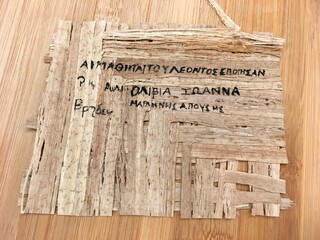
Students in Professor Dan Leon’s Intermediate Ancient Greek class recently got hands-on experience by making paper from papyrus, using the same traditional method developed in ancient Egypt and employed throughout Greek antiquity.
Graduate students and faculty from Classics—including, Leon noted with a smile, “one interloper from Linguistics”—helped cut the reeds into strips, which then soaked in water for three days.
Students experimented with different methods of weaving the reeds into mats, which they then pounded with wooden mallets and rolling pins both to flatten the pages and to release the juices that form a natural glue that holds the strips together. Next, they pressed each page between two cloth towels and weighted them down with heavy books. The towels were changed once or twice per day for about five days, according to Leon.
And just where did the papyrus come from? Surprisingly, from the UI campus, where papyrus reeds—known as “nutsedge”—are cultivated by grounds staff for ornamental purposes. Leon gave a special shout-out to the grounds staff: “They kindly agreed to set the reeds aside for us when the fall growing season ended.” He expressed particular thanks to Ryan Welch, superintendent of grounds for Facilities and Services, and Darren LaReau, grounds sub-foreman for Facilities and Services.
Leon said that he and the participants got a quick appreciation for how difficult this ancient process was. “The first pages we made didn’t turn out too well.” So they examined machine-made papyrus paper purchased from a museum. “It allowed us to see what went wrong with our method and also practice writing on papyrus using bamboo pens and India ink purchased from an art supply store in Urbana.”
Fortunately, Leon said, the grounds staff supplied them with a second batch of papyrus. Although there were fewer plants, they were larger than the first ones, which allowed the class to produce larger strips that were easier to work with. The second time around they soaked the strips for six days, which made them more pliable, and they used a different weaving method that worked much better, said Leon.
Ultimately, the class had enough papyrus to make one good page about the size of a greeting card, according to Leon. They flattened it and placed it under weight for six more days, changing the towels each day. “Once it was dry,” said Leon, “we had a much better piece of papyrus paper than before and we all took turns writing on it.”
Leon said that fellow Classics professors Craig Williams and Clara Bosak-Schroeder “both easily read what we wrote, so we consider our project a success.”
With obvious pride, Leon noted, “The papyrus is being framed now and I plan to hang it in my office (in the Foreign Languages Building).”